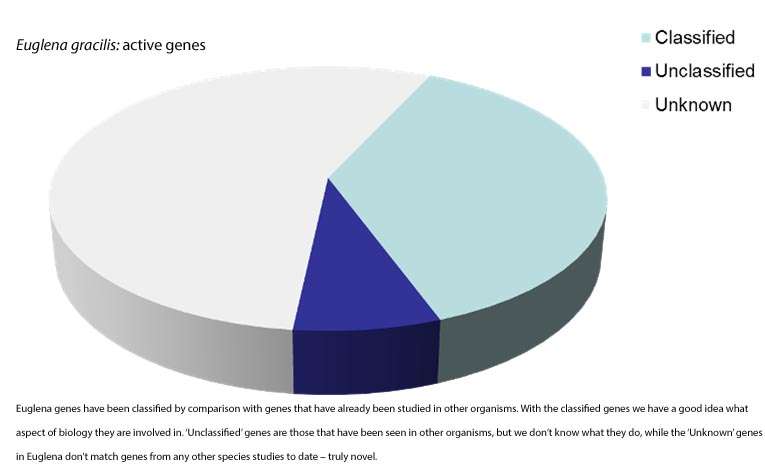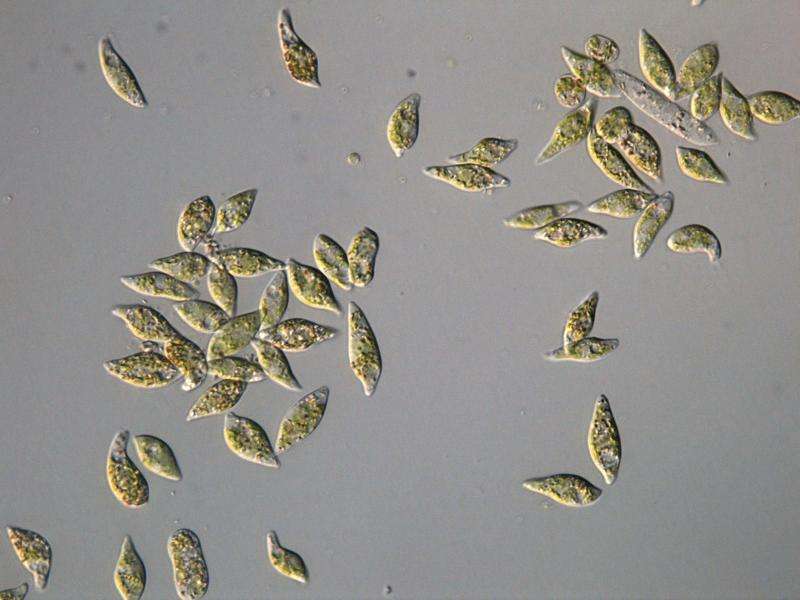The potential in your pond

Scientists at the John Innes Centre have discovered that Euglena gracilis, the single cell algae which inhabits most garden ponds, has a whole host of new, unclassified genes which can make new forms of carbohydrates and natural products.
Even with the latest technologies, sequencing all the DNA in Euglena remains a complex and longwinded undertaking. Dr Ellis O'Neill and Professor Rob Field from the John Innes Centre in Norwich have therefore sequenced the transcriptome of Euglena gracilis, which provides information about all of the genes that the organism is actively using. From this analysis of its RNA molecules, Professor Field and his team projected that Euglena has at least 32,000 active, protein encoding genes, significantly more than humans who have approximately 21,000.
They discovered that Euglena has the genetic information to make many different natural compounds: we simply don't yet know what they are or what they can do. Nearly 60% of the active genes don't match those found in any other organism studied to date, suggesting that there is much to learn about the biology of Euglena.
The team also found that different sets of genes become active when Euglena is grown in the dark to when it is grown in the light. This indicates that Euglena can dramatically shift its metabolism depending on its environment, which reflects its' ability to live successfully in very varied environments.
Euglena creates many well-known, valuable natural products including vitamins, essential amino acids and a sugar polymer which is reported to have anti-HIV effects. Given the usefulness of the compounds we know about, these findings have the potential, with further research, to lead to the discovery of new medicines including new antibiotics, nutrients and new forms of biofuel - amongst other products.

The genetic information in what we think of as simple algae is in fact enormous, which complicates definition of what these organism are capable of and has prompted the science community to largely focus of simpler microorganisms (bacteria, fungi, viruses).
Undeterred by this challenge, the JIC team identified candidate genes in the Euglena transcriptome for all the pathways and metabolic processes that one would expect in a motile, photosynthetic organism. They also discovered unexpected capacity for producing and modifying carbohydrate polymers and the generation of as-yet unknown natural products. Professor Field and his team now look to the scientific community to help classify these new products and determine how they may be used.
Professor Field said:
"We know there are many products made from Euglena which are already on the market – beauty and nutritional supplements, foods and even fuel for cars – all popular in Japan and the Far East. What we didn't realise is that there is so much more that Euglena is capable of producing which could give us new treatments, cures and industrial capabilities. We hope this landmark research will encourage other scientists to build on our findings with Euglena, and other algae, to work out exactly what compounds they make and how we can use them."
Provided by John Innes Centre



















